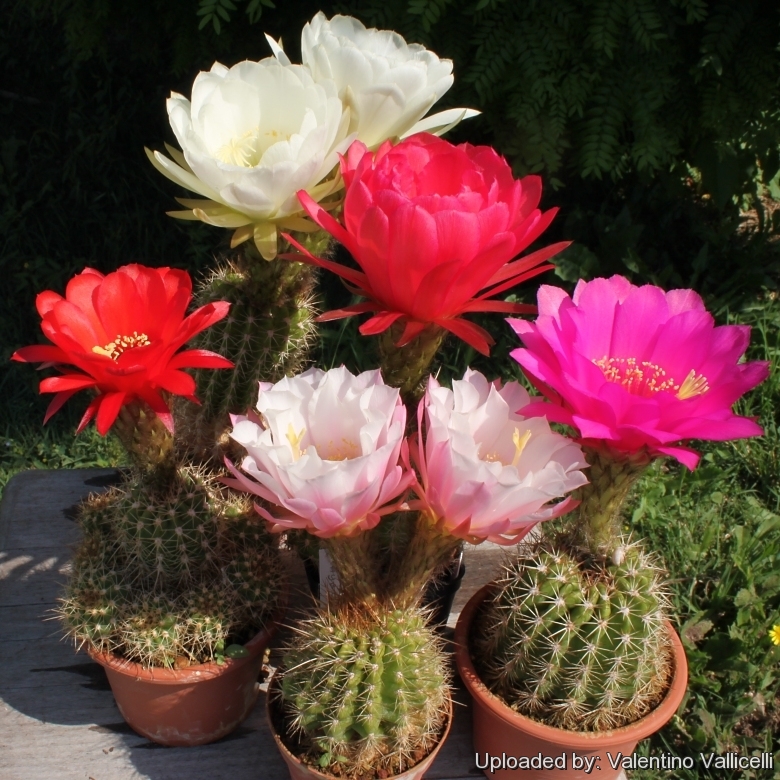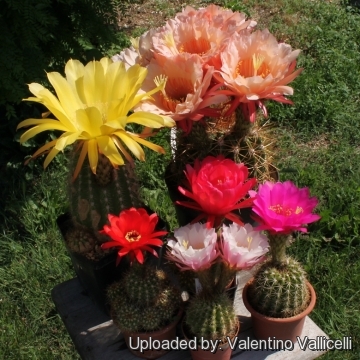Accepted Scientific Name: Echinopsis hybrid (Trichopsis group)
(Tricocereus sp. x Echinopsis sp.)

х Trichopsis hybrids (Echinopsis hybrid (Trichopsis group)) Photo by: Valentino Vallicelli
Origin and Habitat: Garden origin (Nursery produced cultivar) Hybrid Trichocereus sp. x Echinopsis sp.
Synonyms:
Description: The Trichopsis are intergenic hybrids involving a plant of the old genus Tricoceresus and one or more species of the genus Echinopsis (or Lobivia), but since all those genera are now reclassified as Echinopsis, that makes this an Echinopsis hybrid.
Trichopsis are very popular hybrids that develop really amazing flowers of different colours on the original columnar Trichocereus body and many of these hybrids have cultivar names. This plants form spectacular specimens with several large-sized flowers at a time, and are quite a sight. They are often similar in habit and size to Trichocereus with thick, strong, larger-growing columnar stems, but also they shows a mix of characteristics from both the parents. Most of these hybrids can grow outside all year in mild climate and can take a lot of sun. Hardy from -4° to -12° C, depending on clone.
Subspecies, varieties, forms and cultivars of plants belonging to the Echinopsis hybrid (Trichopsis) group
 Echinopsis cv. Apricot Glow: has multi-coloured with delicate shadings of apricot, orange-red and yellow.
Echinopsis cv. Apricot Glow: has multi-coloured with delicate shadings of apricot, orange-red and yellow. Echinopsis cv. Barbara Cornely: Large-sized with beautiful salmon, pink and fuchsia tones.
Echinopsis cv. Barbara Cornely: Large-sized with beautiful salmon, pink and fuchsia tones. Echinopsis cv. Chamäleon: flowers are pastel red-orangish-pinkish on the first day while on the second they became clearly pastel-pink.
Echinopsis cv. Chamäleon: flowers are pastel red-orangish-pinkish on the first day while on the second they became clearly pastel-pink. Echinopsis cv. Chelsea Girl: has multi-coloured flowers with delicate shadings of white, pink and purple.
Echinopsis cv. Chelsea Girl: has multi-coloured flowers with delicate shadings of white, pink and purple. Echinopsis cv. Dione: has bright lilac-carmine blooms with reddish-lilac-coloured margins, paler pink midline, green-yellowish throat.
Echinopsis cv. Dione: has bright lilac-carmine blooms with reddish-lilac-coloured margins, paler pink midline, green-yellowish throat. Echinopsis cv. Gräser Freunde: has bloom of approx 14 cm, bright magenta with a contrasting vermillion midline, the outer petals are dark scarlet.
Echinopsis cv. Gräser Freunde: has bloom of approx 14 cm, bright magenta with a contrasting vermillion midline, the outer petals are dark scarlet. Echinopsis cv. Gräser´s Schönste: it is the most beautiful and most sought “Aporocandicans” with frilled salmon and pink flowers.
Echinopsis cv. Gräser´s Schönste: it is the most beautiful and most sought “Aporocandicans” with frilled salmon and pink flowers. Echinopsis cv. June Noon: has candid white petal with a canary yellow midrib. It is a Dimmitt hybid.
Echinopsis cv. June Noon: has candid white petal with a canary yellow midrib. It is a Dimmitt hybid. Echinopsis cv. Super Apricot V. JB. Kornely: Flowers are multi-coloured with delicate shadings of apricot, orange-red and yellow.
Echinopsis cv. Super Apricot V. JB. Kornely: Flowers are multi-coloured with delicate shadings of apricot, orange-red and yellow. Echinopsis cv. Volcanic Sunset: has dark orange-red, long lasting flowers, with wide petals and rounded tips. 10-12(-15) cm across.
Echinopsis cv. Volcanic Sunset: has dark orange-red, long lasting flowers, with wide petals and rounded tips. 10-12(-15) cm across. Echinopsis cv. Yellow California: has bright yellow flowers with golden-yellow on the inner petals and some burnt orange on back petals and a lighter yellow throat.
Echinopsis cv. Yellow California: has bright yellow flowers with golden-yellow on the inner petals and some burnt orange on back petals and a lighter yellow throat. Echinopsis hybrid (Trichocereus) f. variegata hort.: has yellow and green variegated stems.
Echinopsis hybrid (Trichocereus) f. variegata hort.: has yellow and green variegated stems. Echinopsis hybrid (Trichopsis group): wide heterogeneous category of hybrids involving various Trichocores species (now Echinopsis) and other Echinopsis species and Lobivias.
Echinopsis hybrid (Trichopsis group): wide heterogeneous category of hybrids involving various Trichocores species (now Echinopsis) and other Echinopsis species and Lobivias.
 х Trichopsis hybrids (Echinopsis hybrid (Trichopsis group)) Photo by: Valentino Vallicelli
х Trichopsis hybrids (Echinopsis hybrid (Trichopsis group)) Photo by: Valentino VallicelliSend a photo of this plant.The gallery now contains thousands of pictures, however it is possible to do even more. We are, of course, seeking photos of species not yet shown in the gallery but not only that, we are also looking for better pictures than those already present.
Read More... Cultivation and Propagation: Trichocereus hybrids are very easy to grow and cold tolerant,as low as -5/-12°C (or less depending on clone). They need a fertile, well drained soil mix. Water the plants well and allow them to dry before watering again. This cultivars seem to do better with a little more water than most cacti. In fact, their cultivation requirements are really more like 'normal' plants than most other cacti. During the growing season fertilize them monthly with a balanced fertilizer
Sun Exposure: Outside full sun, but during hot summers the cactus are subject to sun burning, so grow them in light shade. Inside they need bright light, and some direct sun. During winter months, put them in a cool luminous place and encourage them to enter winter dormancy by withholding water and fertiliser over the winter, as they will etiolate, or become thin, due to lower levels of light. They are susceptible to fungal diseases if overwatered, but are not nearly as sensitive as many other cacti, especially in warm weather. They tend characteristically towards black rotted spots unless watering is moderate and only in hot weather. If kept damp through cold periods, they will invariably suffer.
This plants produces large amounts of growth each year if kept well fed and watered throughout the warmest months, particularly if they have been acclimatised to accept full sun. Once these cactus are established they can easily produce 10cm (or more) of growth every year.
Propagation: By seeds or cutting.











